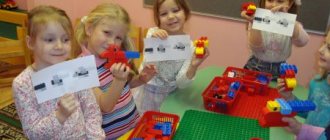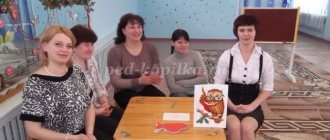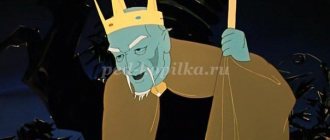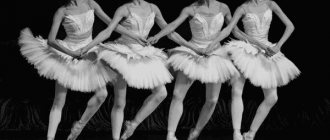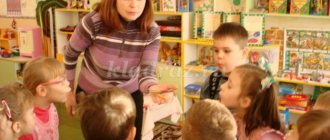Summary of a lesson on speech development “Visiting a fairy tale.” Senior group
Summary of educational activities in the senior group on speech development with TRIZ elements “Visiting a fairy tale”
Description of the material: I offer you a summary of direct educational activities on speech development using elements of TRIZ methods for children of the senior group (5 – 6 years old) on the topic “Visiting fairy tales". This material will be useful to teachers of the senior group. The content of the summary is aimed at teaching children creative storytelling using TRIZ technology. Goal : continue to teach children creative storytelling using TRIZ technology. Tasks. Speech development:
- introduce synonyms into the children’s dictionary: kind, laughing, affectionate, gentle, cheerful, playful;
antonyms: kind, evil, cheerful - sad, healthy - sick and others; - continue to teach children to compose a fairy tale, to connect individual pictures into a single plot with a logical chain of actions and transformations; use expressive means - description; — continue to teach children to formulate complete answers to the question posed; - develop coherent speech, thinking, imagination, fantasy; - cultivate interest in reading, love for oral folk art, fairy tales. Cognitive development:
- improve the ability to use different parts of speech exactly according to their meaning;
— clarify and enrich children’s knowledge about Russian folk and original fairy tales. - learn to use graphic analogy (TRIZ) when highlighting the most important thing in the image of a fairy-tale hero - character; Social and communicative development:
- continue to develop skills in educational activities: act according to the proposed plan, correctly evaluate the results of your activities;
- develop the ability to listen carefully to the teacher’s questions, take turns when answering questions, listen to the other child without interrupting; - develop children’s ability to act in a coordinated manner; - cultivate a friendly attitude towards each other. Physical development:
- develop visual attention and memory;
— improve the ability to coordinate movements with speech. Materials: Two easels;
two pointers; flannelograph; illustrations of fairy tale heroes; diagrams depicting fairy tale heroes and their character; illustration “Confusion”; illustrations for the game “Recognize by the Shadow”; diagrams for the game “Your Own Storyteller”; soft cube; multi-colored landmarks; surprise medals; two physical education arcs. Progress of the lesson.
1. Introductory part. Organizing time. The chairs stand in a semicircle near the board. On each chair there is a landmark (flower). Children come in to the music “Visiting a Fairy Tale” and stand near the teacher. - There are many fairy tales in the world, Sad and funny, But we cannot live in the world without them. Anything can happen in a fairy tale, Our fairy tale is ahead. We will knock on the door of Fairy Tale, Fairy Tale, wait for us for a visit. - Today we are going to visit fairy tales. If you name a fairy tale, then you will take the flower with you. — Name your favorite fairy tale. Children call, the teacher hangs a “flower” on each child’s neck - a landmark. - These are unusual flowers - they will help you travel through fairy tales. All the flowers swayed in the land of fairy tales. Children sit on chairs, each with its own “own” landmark on the back. 2. Main part. — The Wizard from the Land of Fairy Tales put “invisible hats” on the fairy-tale characters, so you need to solve riddles to find out their names. He loved his master, he served him faithfully. He wore boots and defeated the evil Ogre. (Puss in Boots) He hid a lot of silver and gold in his chests. He lives in a gloomy palace and steals other people's brides. (Koschei the Immortal) Ivan has an arrow, Like a bird in flight. Ivan's wife lives in a swamp. (Frog Princess) I caught a pike in the pond and made a wish. (Emelya) Grandmother loved the girl very much and gave her a red cap. The girl forgot her name. Well, tell me her name! (Little Red Riding Hood) - Well done! You recognize all the heroes, but the wizard continues to perform tricks. There is a poster “Fairy Tale Confusion” on the board.
- Look what he did?
(He mixed up all the fairy tales). - What fairy tales did he mix up? Name them. (“Puss in Boots”, “Cinderella”, “Little Red Riding Hood”, “Masha and the Bear”, “The Frog Princess”, “The Princess and the Pea”, “At the Order of the Pike”, “Zayushkina’s Hut”, “The Hare Boasts” ). - Right. What did the wizard mix up in the picture? (Cinderella is given a glass slipper to try on, not boots. It is not Puss in Boots who tries on the slipper, but the prince. The bear is carrying not the Princess - a frog, but Mashenka. The princess on Gorshina sleeps not on the stove, but on a feather bed, but the stove from the fairy tale “According to the Pike command." Little Red Riding Hood meets not a hare, but a wolf. (The teacher removes the poster from the board). - We have all solved fairy tales And found all the heroes. We need to go further. ( Children stand up one after another and follow the teacher.) Physical exercise "On the contrary " Technique of typical fantasy "On the contrary" Task: - to develop thinking, the ability to perform not a direct instruction, but an anti-action, diversify the methods of consolidating individual actions, teach to name antonyms. Children are given the task to perform a certain action, movement - they must perform an anti-action, anti - movement: walking along the bridge. Speed up walking - slow down; Tilt to the right - lean to the left; Walking forward - walking forward with your back. etc. - We will walk along the path We will cross the bridge. (“Bridge” - two arcs. Children pass performing an anti-motion between them) - The one who says the opposite word will walk across the bridge. Flowers will help you find your place. - Cheerful - sad, - kind - evil, - brave - cowardly, - old - young, - strong - weak, - healthy - sick, - smart - stupid, - polite - rude, - well-fed - hungry, - powerful - weak, - mischievous - obedient, - lazy - hardworking. (“The bridge” is removed. We approach the easel. Flowers are laid out on the floor - landmarks. Children stand, each, near their landmark. On the easel are the “shadows” of fairy-tale characters.
- The wizard hid the heroes. If we solve them, we will save them from magic . - We name the shadow, turn it over, see if we guessed correctly. (Baba Yaga, Puss in Boots, King, Emelya, Little Mermaid, Pinocchio, Serpent Gorynych). As they name, the children turn over the illustrations, there is a color image. - All the heroes you found out, now let's rest.
Gymnastics for the eyes. “We came to a wonderful forest. (With our eyes we drew a circle to the right) There are many fairy tales and miracles in it. (Circle to the left) On the left are pine trees - on the right are spruce trees, (With our eyes to the right and left) There is a woodpecker on top, knocking yes knock. (Eyes up and down) Open your eyes, close them. And quickly run home. - Come to the window. Look at the circle on the window, look at the house. How many floors are there in the house? Count it. Look at the circle. - Well done! Let's go back on their chairs.” “While you and I were traveling, the wizard was here again and left us portraits, but unusual ones, portraits - lines.” -What line is this? (The teacher shows a wavy line on the board.) - Yes, it’s a wavy line. — What character should a hero have who can be depicted with such a line? (He should be kind, gentle, affectionate, hardworking, caring) - List the heroes of fairy tales with such a character. (Cinderella, Snow White, Swan Princess, Mashenka, Vasilisa the Wise, Elena the Beautiful). - That's right, why? (They are all kind, generous, caring, affectionate, gentle). The teacher hangs a portrait of Cinderella on the board next to the broken line.
— Do you think a good character can be drawn with a broken line?
(No). -What does this line look like? (It looks like lightning, thorns, needles). - Heroes with what character can be depicted with this line? (They are evil, cruel, heartless, envious). - List them. (Koschei the Immortal, Serpent Gorynych, Baba Yaga, Miracle Yudo. The teacher hangs up a portrait of Ivan the Tsarevich.
- What is the name of this hero? (His name is Ivan Tsarevich). - What line can you draw him? (You can draw him with a straight line) . - Why? What is his character? (He is kind, strong, courageous, bold, courageous, powerful, wise). - List the heroes who have such a character. (Ivan is a peasant son, Ivan is a Tsarevich, Prince Guidon, Tsar Saltan , Elisha). On the board next to the portrait of Ivan Tsarevich he draws a straight line.
The teacher hangs Pinocchio and a line depicting an arc.
- Why did I place this line next to this hero? What is his name? (His name is Pinocchio). - What is his character like? ? (Cheerful, mischievous, funny). - Why is it marked with such a line? What does it look like? (It looks like a smile). - What characters with a similar character do you know? (Emelya, Peter Pan, Carlson). - Well done! You They told you correctly about the heroes. And now you yourself will turn into fairy-tale characters.
Music sounds, children get up, come out from behind the chairs, and build a circle. Psycho-gymnastics. What kind of masquerade is this? And the parade of animals and birds. You can’t make out anything, Where is the squirrel, where is the hedgehog. Get ready and watch the Fairy-tale animal freeze in place. Fairy tales came to visit us Who is who - determine. Pinocchio and Koschey and Malvina and the villain. Get ready and watch the figure from a fairy tale freeze in place. (Children go to their chairs.) The teacher invites the children to compose their own fairy tale. Let's play with cubes, Let's compose a fairy tale. (There is a plan on the easel - a diagram of fairy tales) - The first step is to throw the dice, count how many came up, look for a diagram, this is the beginning of a fairy tale. We make a proposal. We throw the dice again, count, and make up a second sentence based on the scheme that appears. Just five steps. Our fairy tale should be interesting, complete, a miracle and magic should happen in it. It must contain fairy-tale heroes and good defeat evil. (Children compose a fairy tale according to the diagrams that have fallen out, the teacher guides and asks questions.) An approximate version of the fairy tale: see Appendix 1. - Well done! Now it's time for us to return. 3. Final part. Bottom line. — Did you enjoy visiting fairy tales?
- What did you like? What do you remember most? What would you like to know next time? (Children answer.) - Believing in a fairy tale is happiness, And for those who believe, the fairy tale will definitely open all the doors. Appendix No. 1.
Once upon a time there lived a king and a queen. They lived in a large palace. They had no children. They lived a boring life and one fine morning they found themselves on a desert island. It was very beautiful there. Unusual trees grew and wonderful birds sang. On the island they met a kind stargazer, who told them about the planets and showed them through his telescope. The astrologer really liked the king and queen and he gave them a magic apple. They thanked the astrologer and set off on their way back with this apple. It not only showed them the way home, but upon their return it continued to work miracles. And this is what came of it: in due time, a son was born to them and they began to live well and make good money.
We recommend watching:
Summary of a lesson in the middle group on the works of Marshak Notes of the GCD in the middle group “Help the Cockerel” Summary of the GCD in the middle group on the topic: “Who lives in the little house?” Summary of a design lesson in the middle group "Tumbler"
Similar articles:
Math lesson “Rectangle” in the middle group of kindergarten
Information and creative project “Visiting a fairy tale” senior group
Information and creative project
"Visiting a fairy tale"
senior group
October – January 2022
Project title: “Visiting a fairy tale”
Project duration:
short-term (October 2022 – January 2022)
Project participants:
teachers, older children, parents.
Project type:
informational and creative project.
Educational area:
cognitive development, socio-communicative development,
artistic and aesthetic development.
Objective of the project.
Creation of conditions for the formation in children of a sustainable interest in reading fairy tales, development of communication abilities.
Project objectives:
Creating conditions for organizing creative theatrical activities for children.
To develop in students the ability to actively listen to a work, to listen attentively to artistic speech, to understand the meaning of fairy tales and their cognitive significance.
Improve speech culture, children’s ability to reason, apply their knowledge in conversation, and achieve coherent statements.
To develop active, expressive speech through the staging of theatrical activities for children. Enrich and expand children's vocabulary.
To give an idea of the genres of fairy-tale works, to continue to introduce writers who are storytellers.
Develop the child’s cognitive abilities, curiosity, creative imagination, memory, and emotional attitude to what he reads.
To cultivate kindness, justice, love for native culture and respectful attitude towards peers and adults through Russian folk tales;
Create conditions for joint creative activity of children and parents.
Relevance.
Today the topic is very relevant. The role of works of art in the life of preschool children is very important. The most interesting and relevant genre is the fairy tale. A fairy tale for children is a special world, a source of ideas about time and space, about the connection of man with nature, with the objective world. Fairy tales help in the development of children's coherent speech, help to construct dialogues correctly, expand vocabulary, and make the child's speech emotional, imaginative and beautiful.
Project support:
visual teaching aids, books, board games, pictures, theatrical supplies, gaming and materials for visual arts, didactic and board-printed games.
Expected result:
children will develop a love for fairy tales and theatrical activities, children will know and name the fairy tales they have read, their authors, texts, characters, morals; know different types of theaters and be able to show them; be able to use various means of expression; be able to independently choose a fairy tale, carry out preliminary work for its presentation, and get used to your role.
